The Berkshires Bowling Alley that Inspired "The Big Lebowski"
It’s been 36 years since the release of The Big Lebowski, the irreverent cult comedy by Joel and Ethan


Union Square, one of New York City’s major intersections, has quite a reputation. It is many things: a lively rallying site, a place to eat lunch or play a vigorous game of chess, a shopping center, a destination for hip eateries, and more. It’s hard to find anyone in New York who hasn’t enjoyed some aspect of Union Square.
Union Square had its humble beginnings in 1811, when the gridiron plan of Manhattan was approved. Originally named “Union Place” because it was the “union” of Broadway and 4th Avenue (formerly Bloomingdale Road and Bowery Road), it was created by the City Commissioner and formally became a public area in 1831.
It became a more welcoming space after renovations (partially done by Frederick Law Olmsted and Carl Vaux, who also designed Central Park) in 1872. While they intended for Central Park to be more natural and “romantic,” Union Square was specifically meant to be a more rigid, “public forum” kind of space.
Naturally, Union Square has both a rich history and fascinating current structures that are worth delving into. Read on to discover the secrets of one of the most popular, vibrant intersections in New York City.

If you were to walk out of the Union Square subway station and look around you, one of the first things you’d immediately notice is the large art piece and extensive digital clock on a wall at Union Square South. This installation, called Metronome, was one of the priciest private commissions of public art in New York City and still continues to confound passerby today, who often think it’s a national debt counter.
The wall sculpture itself has several components.The brick, ripple-patterned wall is called “The Vortex,” “The Relic” is the hand located at the top, the center hole that puffs steam is “The Infinity,” the gold specks on the wall are collectively called “The Source,” and the rock fragment, also on the wall, is “The Matter.”
The 100 by 62 foot Metronome has been here since 1999 and was created by Kristin Jones and Andrew Ginzel for a Union Square South developer, The Related Companies. The wall sculpture features a concentric circles that become progressively smaller as you go inward.
The hole in center of the circles expels large puffs of steam at noon and midnight with a burst of sound to mark the time. According to the artists, its purpose is to create “a dialogue between the public and their city as the eight elements evoke the city’s pulsing rhythms, daily rituals, and its astronomical and geological history.”
The digital clock, called “The Passage,” is a crucial component of the installation. As we’ve mentioned before, the numbers on the clock not only count the day’s 24 hours (shown on the rightmost seven digits), while simultaneously displaying how many hours are left in the day (shown on the leftmost seven digits). The center digit is a mesh of values coming from both sides. The clock uses military time and rounds to the nearest hundredth of a second.
With such a complex system, it’s not surprise that there have been a few mishaps. In 2010-2011 it ran forty minutes slow and consequently confused New Year’s Eve celebrants.
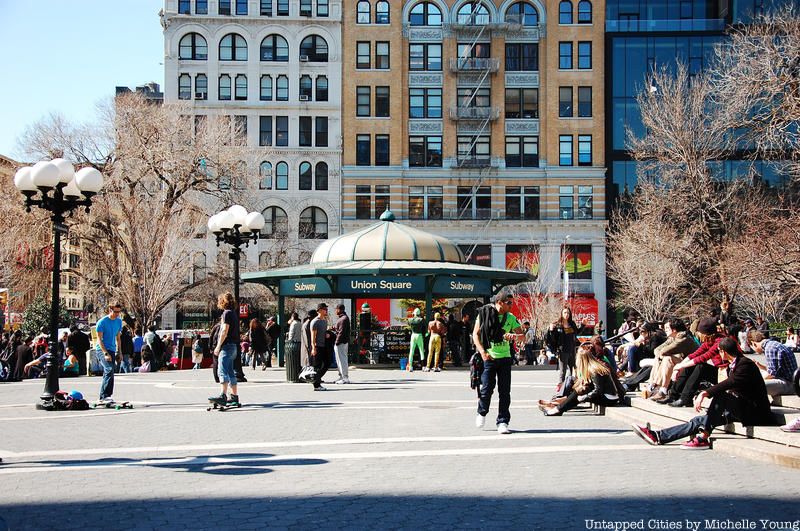
It’s hard to believe that this lively area was a potter’s field, where the city’s poor or unidentified were buried. Potter’s fields such as these came and gone as urban growth increased land values. Its location at 14th street and Broadway meant that it had to be put to more efficient use, namely, a park. Discover what other New York City parks used to be cemeteries.
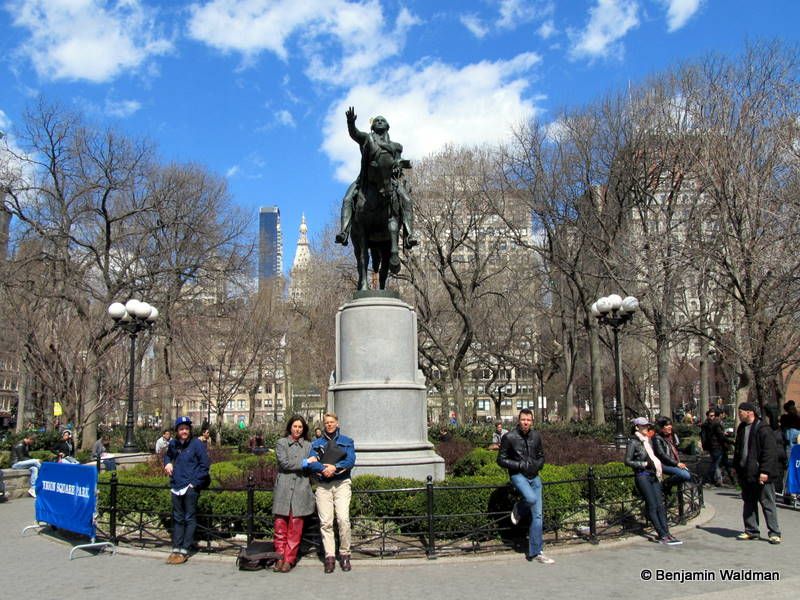
The statue of George Washington in Union Square Park
The tall statue of George Washington proudly on his horse in Union Square Park is not only the first bronze-casted equestrian statue in America, but also the oldest sculpture in the New York City Parks collection. It was the first public sculpture in New York City since that of George III before the American Revolution.
The statue, created by Henry Kirke Brown and dedicated in 1865, depicts Washington on Evacuation Day, which was when he reclaimed New York Town on Manhattan Island, and then triumphantly marched south down Manhattan towards the Battery. The sculpture originally stood outside the park on Fourth Avenue but is now located inside the park.
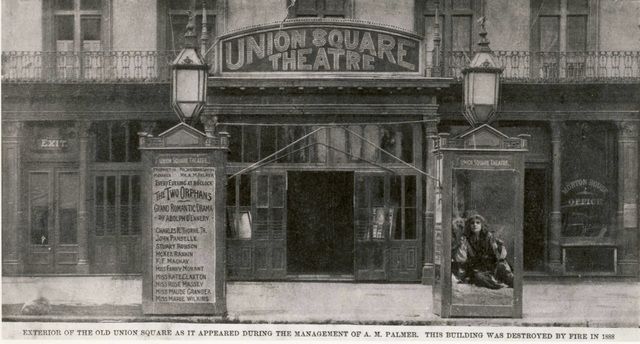
The Union Square Theater was an important part of “The Rialto.” Image via Wikimedia Commons
From the 1860s to 1880s, Union Square was called “The Rialto” after a commercial district in Venice, as it served as the city’s main theater district, drawing large crowds of audiences and actors. There was the Union Square Theatre (which was built in 1870 where the Metronome is today). It functioned as initially a variety theater, but was purchased in 1893 and subsequently became a vaudeville theater. In 1908, it became a movie theater.
There was also the Academy of Music on 14th street in Union Square, which is known as the first successful American opera house. It closed in 1887 due to competition from the Metropolitan Opera.
Besides eager, wealthier audiences, struggling actors also gathered in this thriving theatrical area, where agents and managers would seek show casts for the season. A 1921 New York Times article even called this area the “Slave Mart” because of this practice. The district eventually moved uptown.
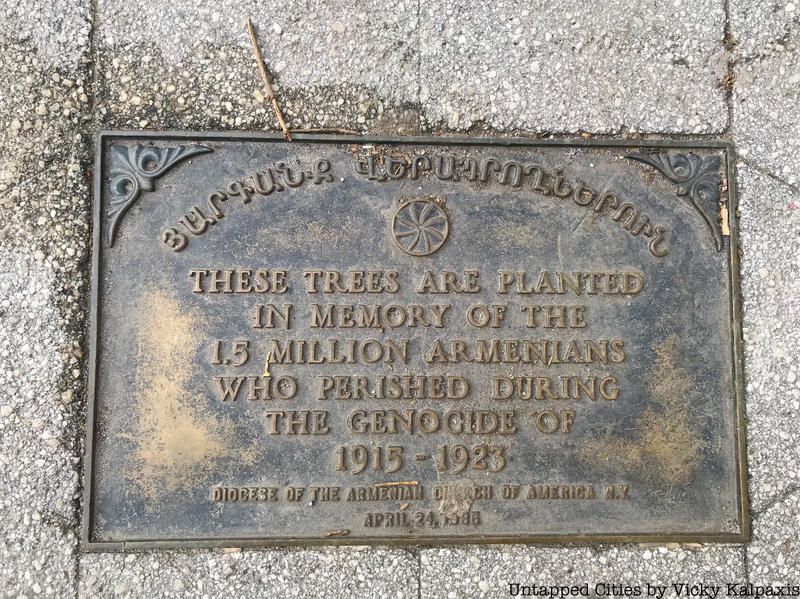
In the northeast corner of Union Square Park lie a row of trees with a plaque. Though they just seem like normal trees, they were actually planted about thirty years ago to remember the Armenian Genocide that occurred in the 1915-1917.

Image from Library of Congress
Historically, Union Square has been the site of many demonstrations, including rallies during the Civil War. You might be surprised to know that the city was once required to construct places for people to protest–this pavilion is an example. This is the front, during a socialist and labor union demonstration on May Day at Union Square and these are the stands in the back, during a barber’s strike.
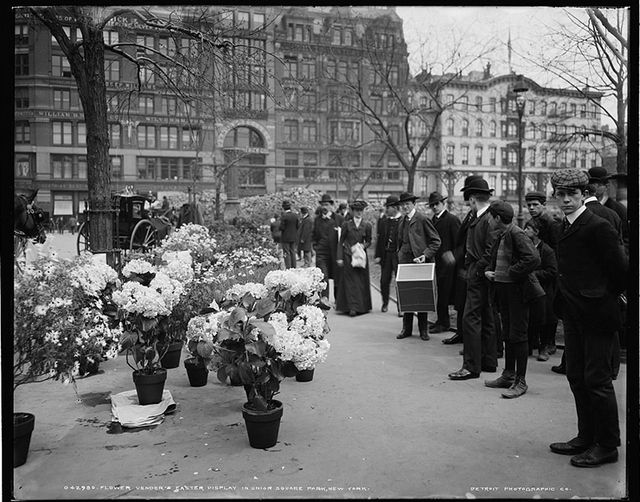
Photo from Library of Congress
The Union Square Greenmarket has provided fresh food and plants from local farmers to the public since 1976. As New York City’s first and largest greenmarket, it serves over 250,000 people during peak season, with about 140 participating farmers and producers. Though the very first market had only seven participating farmers, its success actually sparked the revitalization of the entire Union Square neighborhood, which had a become a declining area with drug problems during the 1970s. But before the Union Square Greenmarket came to Union Square, another kind of market flourished in the area a century earlier: a flower market within the very same stands where protesting took place.
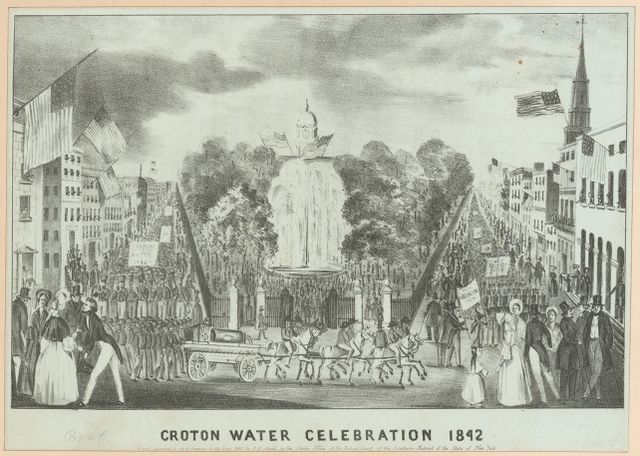
The celebration of the Croton Aqueduct. Image via New York Public Library
When the Croton Reservoir aqueduct was completed in 1842, New York City residents could finally receive uncontaminated supplies of water. This was a huge achievement considering the cholera epidemic that hit New York ten years prior. Thus, in celebration, a large central fountain was erected in Union Square the same year.
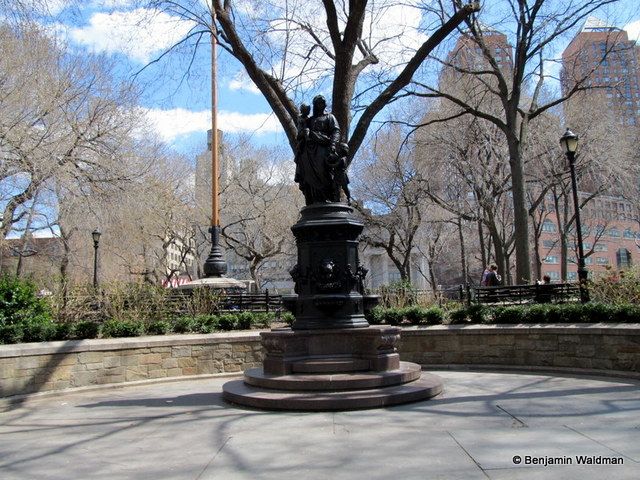
The James Fountain is still in Union Square
Though the former fountain no longer exists, an exquisite bronze sculpture and drinking fountain from 1881, called the James Fountain, lies on the west side of Union Square Park. The purpose of the fountain was to promote the Temperance Movement using the idea that accessible cold drinking water would reduce the public’s desires for alcohol.
A second temperance fountain resides in Tompkins Square Park, and both are among the rare temperance fountains left around the nation.
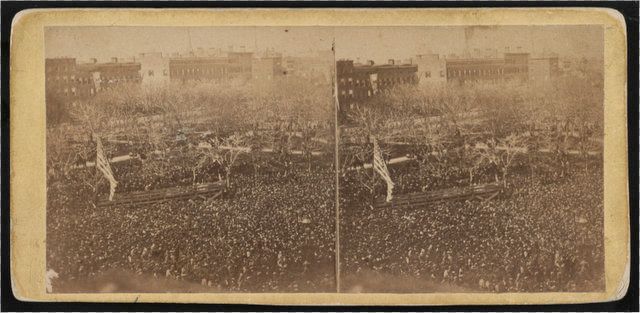
The 1861 rally in Union Square. Image from Library of Congress
A variety of heated protests have occurred within Union Square over the years, and this reputation actually started during the Civil War. On April 20, 1861, just seven days after the start of the Civil War, about 100,000 people gathered in support of the Union, near the place where the George Washington statue used to be.
Before this, the Union had surrendered and experienced huge losses at Fort Sumter. Major Robert Anderson, who lowered the flag in surrender, then brought it to the rally and placed it in the hands of the George Washington statue. At the rally, distinguished men spoke from five stands around the square. This was the largest public gathering ever organized in the U.S. at the time.
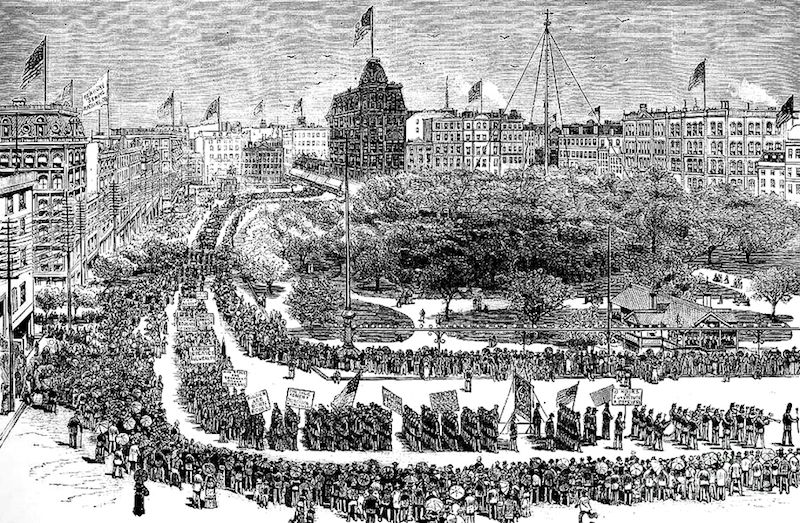
A sketch from 1882 showing the first Labor Day Parade congregating at Union Square. Image source: Wikipedia Commons.
Another important gathering that occurred at Union Square was the very first Labor Day parade in U.S. history. This was in 1882, and celebrated American workers with a picnic, concert and speeches. During this time, 10,000 workers marched from City Hall to Union Square, taking unpaid time off work to do so.
The very first Labor Day was held on a Tuesday, September 5, 1882, in New York City. The day was celebrated with a picnic, concert and speeches. Ten thousand workers marched in a parade from City Hall to Union Square.
In fact, Union Square played such an important role in American history that the U.S. Department of the Interior made Union Square Park a National Historic Landmark because of its significance in U.S. history.
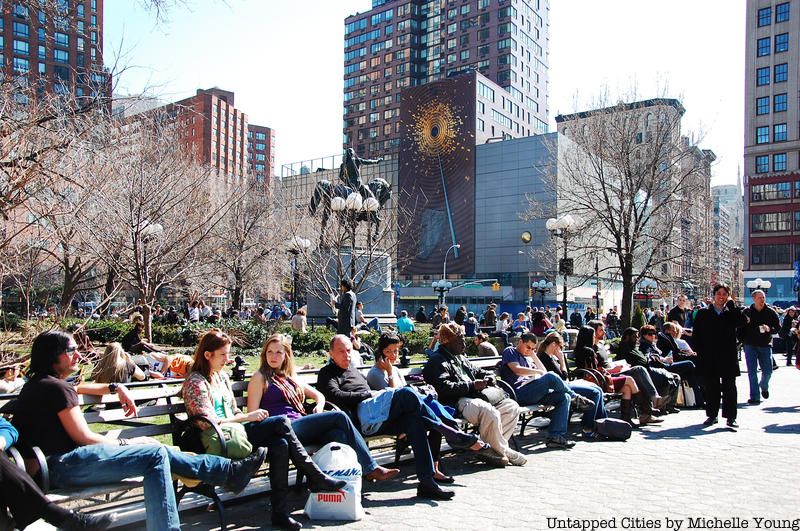
To allow for a new underground subway passageway and smaller alterations like straightening paths, a new pavilion, and the dedication of the sculpture the Independence Flagstaff, Union Square Park was almost entirely demolished in 1928-1929. The Flagstaff, created by Anthony de Francisci, was dedicated in 1930 to comemmorate the 150th anniversary of the signing of the Declaration of Independence. It was donated by Tammany Hall (whose presence we’ll discuss next) and stood in the place of the fountain celebrating the Croton Aqueduct.
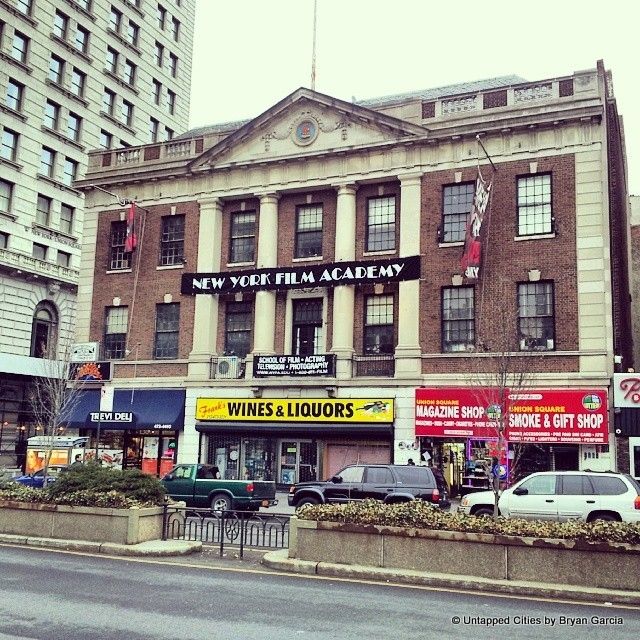
This New York Film Academy building used to be the Tammany Hall headquarters
Unbeknownst to many, you can still see the presence of Tammany Hall, the Democratic Party political machine once led by the corrupt Boss Tweed, at 100 East 17th street in Union Square. Though it is now occupied by the New York Film Academy, the building is an official New York City Landmark that still has the Tammany Society seal and sculptural reliefs of Chief Tammany and Christopher Columbus.
Commissioned in 1927, the political machine already began to lose power by the time it was completed in 1929 due to corruption scandals. The organization continued to meet here at “The Hall” until 1943, when Local 91 of the International Ladies Garment Workers Union bought the building. Both the Union Square Theater and the New York Film Academy moved in almost 50 years later.
With its inscription “1786 THE SOCIETY OF TAMMANY OR COLUMBIAN ORDER 1928” and the Tammany Hall motto “Freedom Our Rock,” it is the the 17th street exterior that shows blatant signs of Tammany Hall’s presence. Read more about it here.
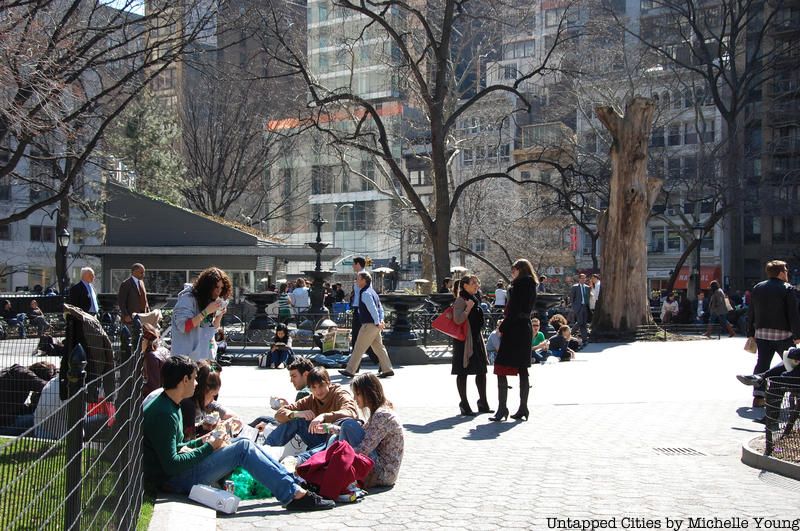
The funeral processions of both Andrew Jackson (in 1845) and Abraham Lincoln (in 1865) traveled through Union Square. Accompanied by 300 people, Lincoln was carried along the boulevards of big cities on a 1,654 mile route he himself traveled as president.
Another presidential fun fact: Theodore Roosevelt and his brother Elliott watched Lincoln’s procession from a second-floor window in his grandfather’s Union Square mansion when he was 6 years old. Roosevelt’s father used to go to church with Lincoln and his wife, and Teddy would call Lincoln his “great hero” as president. So yes, Teddy Roosevelt used to hang around Union Square too.
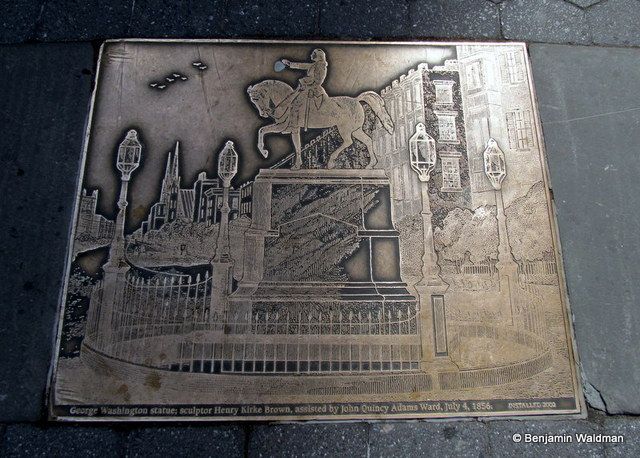
A plaque showing Union Square’s George Washington statue
Look down as you walk around the park’s outside and you’ll see artistic bronze plaques depicting significant scenes from Union Square’s rich history and the Labor Movement. The art sequence was created by Gregg LeFevre in 2002, and capture moments from the past 172 years. We previously took pictures of and described the plaques here.
Next, read about The Top 10 Secrets of Washington Square Park. Get in touch with the author @sgeier97
Subscribe to our newsletter